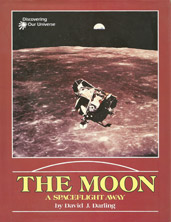THE MOON: A Spaceflight Away - 4. A Walk on the Moon

The side of the Moon that faces Earth.
The film has ended. A steward tells us that our spaceship is about to land. Just a few minutes later, dust sprays up past the window, and we feel a gentle bump as our spaceship touches down on the Moon's surface.
Spacesuits on, everyone! Since there's no air on the Moon, we must take a supply with us. Check your radio. It's the only way we'll be able to talk to each other. Because, there's no air, there can be no sound on the Moon either.
Check your cooling systems, too. Since we'll be on the Moon's surface during the day, the temperature outside our spacesuit will be as high as 260°F (127°C). If we were to walk on the Moon at night, we'd need a heating system. The temperature then would be a bitterly cold -320°F (-195°C) or even lower.
Now let's step onto the Moon. Look at the colors around us. The surface is a light gray, not at all like the bright yellow of the Moon seen from Earth. The sky is an inky black, studded with stars that look so much brighter than they do from beneath Earth's blanket of air.
Jump! Even with your spacesuit on, you're several times lighter than you were on Earth. The Moon's surface gravity is just one-sixth that of Earth's. Since you weigh less on the Moon, you can jump much higher.
As we walk around, we can see that the Moon's surface is covered with a layer of dust. Notice how fine it is. Every step you take, you leave a perfect print of the sole of your boot.
There are rocks lying everywhere, too. In places, huge boulders stand as big as a house. There are craters, large and small. Some are so worn down that you can hardly tell they are there. Others stand out more clearly. Often the craters overlap or lie inside one another.
In the distance, mountains rise into the velvety black sky. Moon mountains have smooth tops and smooth sloping sides. It's hard to tell how far away they are because there's nothing in between - trees or houses or fields – of which we know the size.
Everywhere we look, the land is dead and barren. The Moon is certainly not a friendly place to be. But then we notice, in the dark sky above the Moon's surface, something that makes us feel much better. It is our home planet, the Earth, seen from a quarter of a million miles away – a beautiful blue, brown, and white island of life floating in space.

